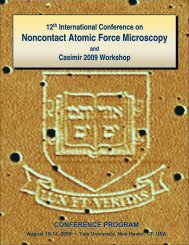Circuit Quantum Electrodynamics - Yale School of Engineering ...
Circuit Quantum Electrodynamics - Yale School of Engineering ...
Circuit Quantum Electrodynamics - Yale School of Engineering ...
You also want an ePaper? Increase the reach of your titles
YUMPU automatically turns print PDFs into web optimized ePapers that Google loves.
CHAPTER 1. INTRODUCTION 33<br />
cesses in the Cooper pair box, with a focus on how the CPB can be made robust against each type<br />
<strong>of</strong> noise. As a result <strong>of</strong> this type <strong>of</strong> analysis a new derivative <strong>of</strong> the CPB called the “transmon” is<br />
introduced that has very promising characteristics. Next, in chapter 5, the design and fabrication<br />
<strong>of</strong> the cavities and qubits is discussed. This section is meant to be a design guide, by which one can<br />
realize the desired parameters in a physical circuit. The appendices associated with these chapters,<br />
while not necessary for understanding, present some more involved derivations and perhaps most<br />
importantly provide a convenient formulary for circuit QED. The measurements are performed at<br />
gigahertz frequencies at one-hundredth <strong>of</strong> a degree above absolute zero, requiring demanding mi-<br />
crowave and cryogenic engineering. The cryogenic and microwave engineering techniques used in<br />
these experiments are explained in chapter 6. The data begins to flow in chapter 7 where the cavities<br />
and circuit QED system are experimentally characterized, with a focus on how to find one’s way in<br />
a rather large parameter space. The rest <strong>of</strong> the results are divided into two general classes <strong>of</strong> exper-<br />
iments focusing on spectroscopic and time domain results respectively. In Chapter 8 spectroscopic<br />
experiments observe the vacuum Rabi splitting, emphatically demonstrating that these circuit QED<br />
experiments reach the strong coupling limit. Spectroscopy in the dispersive limit shows the ac Stark<br />
effect, where the transition frequency <strong>of</strong> the qubit is shifted proportional to the number <strong>of</strong> photons in<br />
the cavity. Further experiments take this one step further making the dispersive coupling so strong<br />
that the qubit absorption spectrum splits into photon-number peaks, the first demonstration <strong>of</strong> the<br />
strong dispersive coupling regime. Chapter 9 then studies time resolved measurements performing<br />
detection and manipulation <strong>of</strong> the qubit state. While spectroscopic measurements are well suited to<br />
study the static energy spectrum <strong>of</strong> the system, time domain measurements are particularly adept<br />
at observing the dynamics <strong>of</strong> a single qubit or photon. In this section we realize the first high visi-<br />
bility measurement <strong>of</strong> a superconducting qubit, and study the fidelity <strong>of</strong> single-shot readout. Using<br />
the cavity-qubit coupling we are also able to map the qubit state onto a single photon, creating an<br />
on-demand single photon source. This thesis work was not a single experiment, but the creation <strong>of</strong><br />
a platform for studying cavity QED and quantum information in a new way. Chapter 10 discusses<br />
a few possible directions for further experiments.















